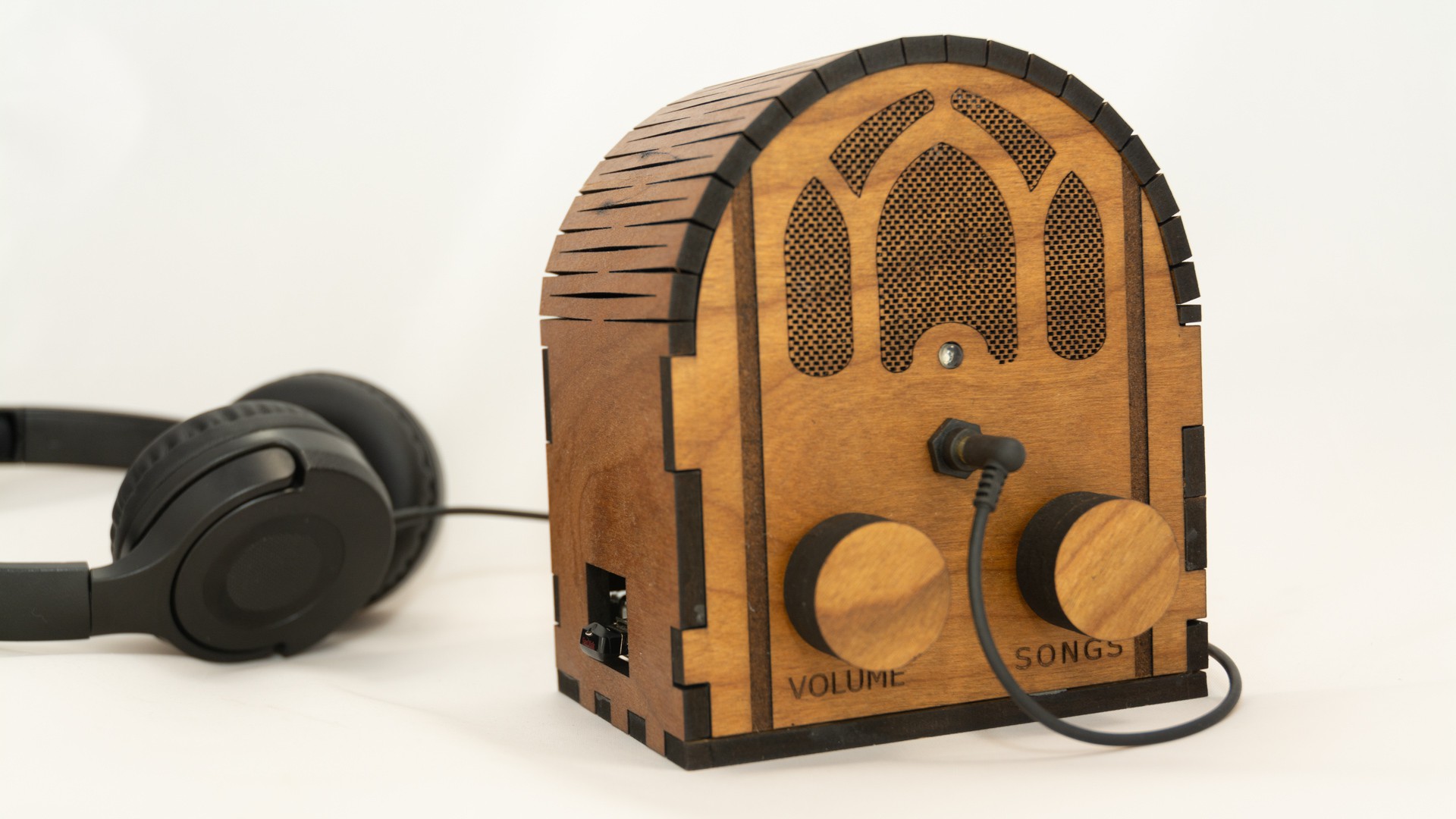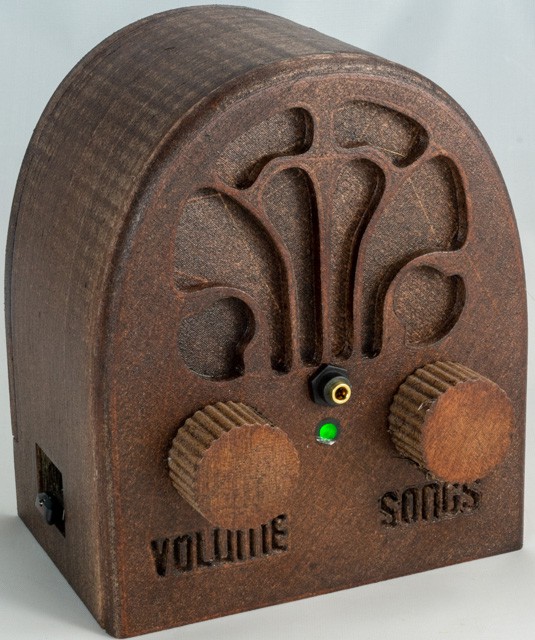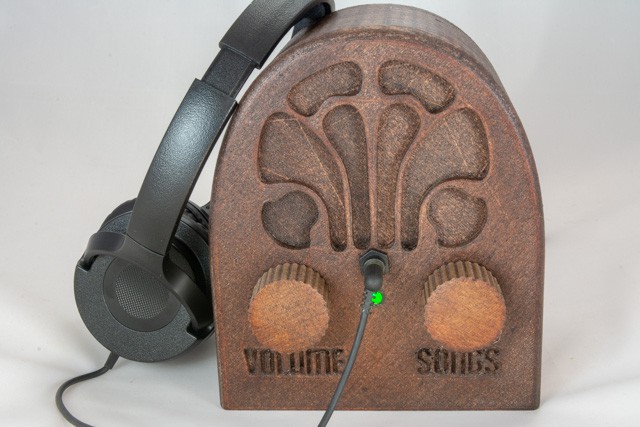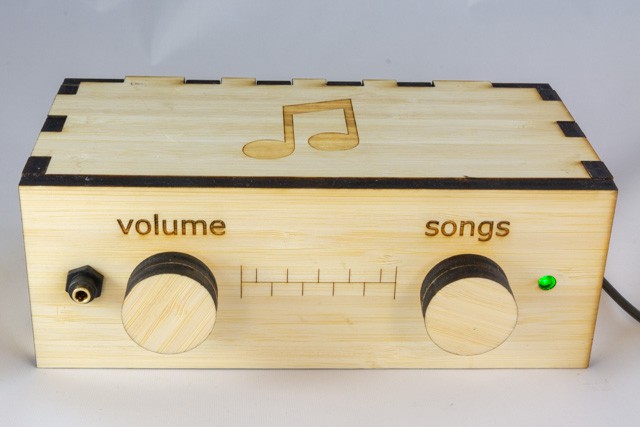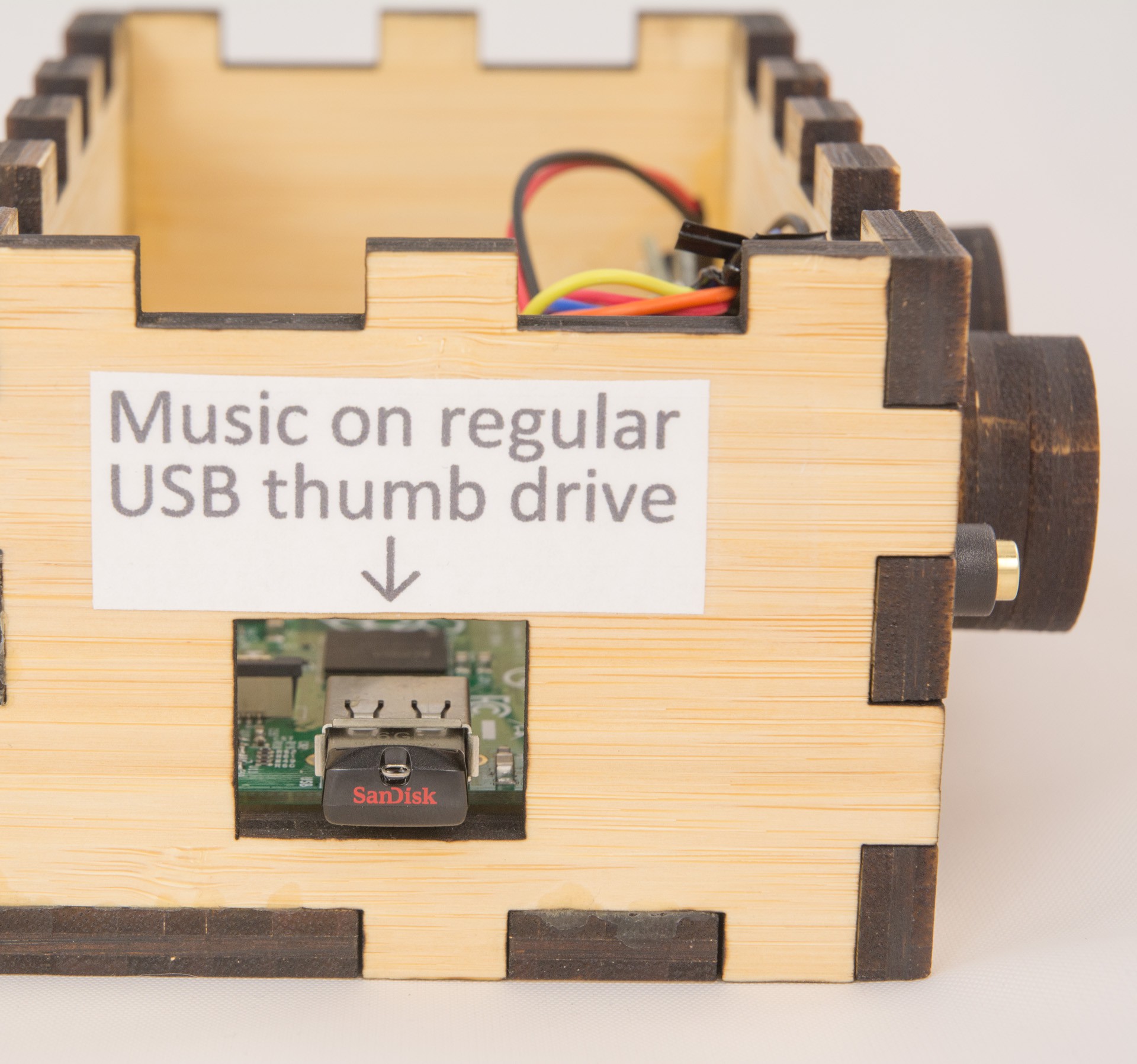-
Laser Cut Cathedral Style Model Now Available
08/11/2018 at 18:25 • 0 comments![]()
New model available for making. Laser cut cherry. In the style of a vintage cathedral radio. Easy to make - no soldering. Same interior parts & software bits as in earlier models.
-
Going to the Bay Area Maker Faire?
05/18/2018 at 03:52 • 0 commentsHi There. If you are going to the Bay Area Maker Faire you can stop by and see the Dementia Friendly Music Player. It will be at the Makers Making Change table which is in Zone 2 in Expo: South. I'll be at the table much of the time. See you there.
Best,
Ross -
3D Printable Model Now Ready
05/13/2018 at 21:57 • 0 commentsThere is now a 3D printable retro-style case available for the project. For people with dementia, the strongest memories are often of their youth. So I had wanted a case that follows the "cathedral" style of that era. Thanks for new volunteer Trey Bagley for the wonderful 3D design. Shown below is a 3D print with wood PLA then stained with regular wood stain. The components on the inside haven't changed - it's still an easy no-solder project.
![]()
![]()
You can still laser cut a case, see below. This design has worked very well for people with dementia.
If you don't have a 3D printer or a laser cutter, no worries. You can order the laser cut case parts for ~$29 from an online laser shop (see the build instructions).
![]()
For more information, including plans and build instructions, see http://dqmusicbox.org.
Enjoy!
Ross
-
Happiness, Scaling, 3D Printing
11/05/2017 at 23:12 • 0 commentsIt's been a fun few days on the project.
I spoke with a group that connects non-profits with needs to makers with skills. That could turn out to be a really good way to get more dementia-friendly music players to people that need them.
I talked with a 3D printing expert who gave me some tips on designing a 3D printable case, as an alternative to the current laser cut case.
And I got a wonderful message from someone that made a dementia-friendly music player for his father. This is why we do it:
I recently assembled a dqmusicbox per your instructions - and it just . worked. Yesterday I turned over my incarnation of the box to my father. It has been a long time since I saw such an emotional reaction from him. I let him at it without explanations at all, and he made it work without instructions. He could not help me much naming songs and music he would like for the box, so I went from my own memory of what he enjoyed listening to. Some of his favorites triggered immediate responses - I should have filmed it. It is perhaps early to say, but I think this is a very nice thing for him to have, and that he will be enjoying it quite a lot down his path.
-
The Eight Evenly Weighted Criteria
10/21/2017 at 04:20 • 0 commentsThere are eight evenly weighted criteria for this Final Round of the 2017 Hackaday Prize. How did the project do? Here is my biased evaluation. This is sort of like doing a self-evaluation at work. That is, it’s important to convey key information, be self-critical, but also a bit self-promotional :-).
1) How thoroughly have the final round requirements been completed?
I have built about a dozen working prototypes. Other makers have built ten units that I know of. I published a video that “sells” and demonstrates the device to a non-technical audience. I published 17 project logs. The build instructions are detailed, illustrated (photographs), and have been tested by non-technical makers. I also published a requirements document, a design document, and instructions for creating the software image (the mini distribution). There is a complete components list on both the Hackaday site and in the build instructions. These lists include links to the components. The build instructions have product links for both the US and the UK. The build has been shown to be reproducible by other makers. There is deliberately no custom hardware in the project, so there are no schematics, though there is a wiring diagram. This is deliberate – I want to keep the build accessible to as many makers as possible so devices get into the hands of people in need.2) Does the project benefit society in some way?
Yes, it can specifically help those with mild dementia find joy in listening to their favorite music. Another benefit is that makers, including young makers, can find joy in helping their elders. There are approximately 47 million people worldwide with dementia. I was inspired by the documentary Alive Inside which shows that people with dementia can find profound joy from listening to their favorite music. The documentary covers the Music & Memory Foundation. There are now 3,000 care institutions that have Music & Memory programs. However, many people with dementia are no longer capable of using modern technology like iPods and CD players. Feedback so far suggests that people with mild dementia can generally use this dementia-friendly music player. Presumably because the old-timey two-knob approach depends on the old strong memories, not the often weaker memories of more recent decades. It certainly worked for my Dad.3) How well documented is the project?
The build instructions are working for other makers (at least ten makers have done builds). The build instructions include 23 photographs / diagrams / screenshots of key steps. One veteran maker on YouTube described the build instructions as the most professional that he's seen in a long time. And for those that want to extend the project, I also published a requirements document, a design document, and instructions for creating the software image (mini distribution). All of this is in github of course. And there is a project site: http://dqmusicbox.org.4) Is there base-level planning for the functionality (e.g. functional block diagram, list of specifications and how they will be met, etc.)?
Yes. See directly above.5) Is there a depth of design detail available (like a system design, CAD models, project test methods, etc), and how well do they demonstrate the project impact and viability?
See above for discussion of depth of design detail and project impact. Regarding project viability, I believe in direct audience feedback. There are about 20 units in the world right now, and the feedback from dementia caregivers has been fairly positive – people with mild dementia can generally use the device and find joy in their favorite music. No reported reliability issues from caregivers or makers.6) Is the project creative, original, functional, and pushing boundaries?
It is creative and original in the sense that I couldn’t find anything else like this (if I had, I would not have done the project). It’s fully functional, and working for other makers. Is it pushing boundaries? It does use a TMP_WRITE_PROTECTED micro-SD card. And it takes an unusual route to get great sound from the Pi’s built-in headphone jack. But other than that, it deliberately doesn’t push any boundaries – I wanted to easy enough for lots of people to build (including kids).7) How “Open” is the design? Preference will be given to projects that exhibit depth of Open Hardware and Open Source Software.
It’s all open source of course. The code uses GNU General Public License, version 2. The laser cut wood case design uses Attribution-NonCommercial-ShareAlike 2.0 Generic (CC BY-NC-SA 2.0).8) Is the project reproducible (consider materials, skills, and processes) and could the work be extended for other uses?
It’s definitely reproducible. I’ve watched seven people make the device so far, including a ten year old (with a little help from his Dad). I didn’t need to offer much help to any of them. It uses normal materials for a maker project e.g. a Raspberry Pi. No special tools or skills are required (no soldering, no woodworking), Can it be extended for other uses? I have started to see some people use it for seniors that don’t have dementia. One maker chose to make a music player that used my design on the inside, but used his own 3D printed case on the outside, which was cool to see. I’ll be interested to see where this goes. It would be awesome if someone made a cathedral-style radio case (the iconic radio style from the 1930s). And it would be great if someone kept the 1940s two-knob radio approach but connected it to Spotify or something else in the cloud. A rather nice person on Hackaday has also talked about integrating old-time radio content. For those that want to extend the project, I have, as noted above, published a requirements doc, a design doc, and a doc on how to create the software image.And of course, I've had a lot of fun doing this. Thanks for the opportunity!
-- Ross
-
Getting Really Good Audio Quality from a Raspberry Pi
10/20/2017 at 06:10 • 0 commentsSeveral people have asked me about the audio quality of the dementia-friendly music player, given that it uses a Raspberry Pi. Raspberry Pis are known for good but not great audio quality from the built-in headphone jack. But you can now get really good audio quality from the Pi's built-in headphone jack. You need an experimental firmware update from the Pi Foundation, see this raspberrypi.org thread. Or see how I built the software image for the dementia-friendly music player. Prior versions of the Dementia-friendly Music Player used a USB audio adapter. And the very first version used a rather expensive external USB audio adapter with an integrated headphone amplifier. But it's really hard to hear the differences between those three versions. So the current version just uses the built-in headphone jack. In other words, the firmware update is pretty darn effective. It's an experimental firmware update, but for my limited purposes it's been wonderfully reliable. The firmware update works with the Pi A+, Pi 2, and Pi 3.
I should also note that the Dementia-friendly Music Player supports MP3, AAC/iTunes, FLAC, and Ogg Vorbis music files.
-
Schools?
10/20/2017 at 05:02 • 0 commentsI think this would be a good class project. Maybe a middle school class. Get a local business to sponsor the parts. Let the kids choose the recipient - maybe a senior care center in their neighborhood. The seniors get something they need. And the kids get the joy of making and of meaningful giving.
The above is not my idea. It comes from a conversation with Michael Rossato-Bennett. He is the director of Alive Inside, the documentary that inspired me to do this. I don't remember his exact words, but it was something like, "When the young help the old, everybody wins". I later corresponded about this with Dan Cohen. Dan is the founder of the Music & Memory Foundation which has trained and certified thousands of care institutions on implementing personalized music programs. He agrees about getting schools involved. So it's probably a good idea.
But I don't know how to get started with schools. If any of you have advice, I'm all ears.
-- Ross
-
Why is the Case Laser Cut Rather than 3D Printed?
10/19/2017 at 07:08 • 0 commentsWhy is the case laser cut rather than 3D printed?
- Because 1940s radios were made of wood. IMHO, the device is usable because it is familiar to people whose memories of the 1940s and 1950s are much stronger than recent memories. My Dad was immediately able to use it, saying that it "felt familiar". And I think the wood helps with that.
- Inexpensive. A company will laser cut the case for you for $28.
But I would like to try doing a 3D printed case. If you read the discussion page for this project, you'll see that Dave Neff made a 3D printed case. He made a larger version of the dementia-friendly music player and added speakers. Nice work. I'd like to try making a regular-sized 3D printed case. A key reason that I want to try this is that there seems to be a small army of makers with 3D printers that just love to make things for themselves and others.
-
Why no Cloud?
10/19/2017 at 06:50 • 0 commentsSome people have asked if an Internet connection is required for operation. NO. And that's deliberate. I want to keep it simple for the caregiver. I don't want the caregiver to have to deal with wi-fi problems. Or deal with ongoing software updates to fix security problems. So the dementia-friendly music player is not an Internet of Things device. It's just a Thing. And it's happy being a Thing. Sort of like a standalone CD player that is pretty happy in it's own little world.
-
Music is Stored on a Regular USB Thumb Drive
10/19/2017 at 06:30 • 0 commentsA number of people have asked where the music is stored. It's stored on a regular USB thumb drive. This is to make it easy for a caregiver to change the set of music from time to time. And to make it even easier, the thumb drive is externally accessible. Caregivers generally seem pleased with this approach. An earlier version stored music on a micro SD card (alongside the OS), which is the cheapest way to go. But I reasoned that most people aren't used to working with micro SD cards, so I changed to the USB thumb drive approach.
![]()
Dementia-friendly music player
Lovechild of MP3 & 1940s radio UI. For seniors with dementia who can no longer use CDs & iPods. Good project for kids.
 Ross Porter
Ross Porter